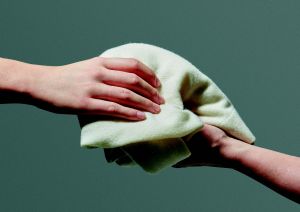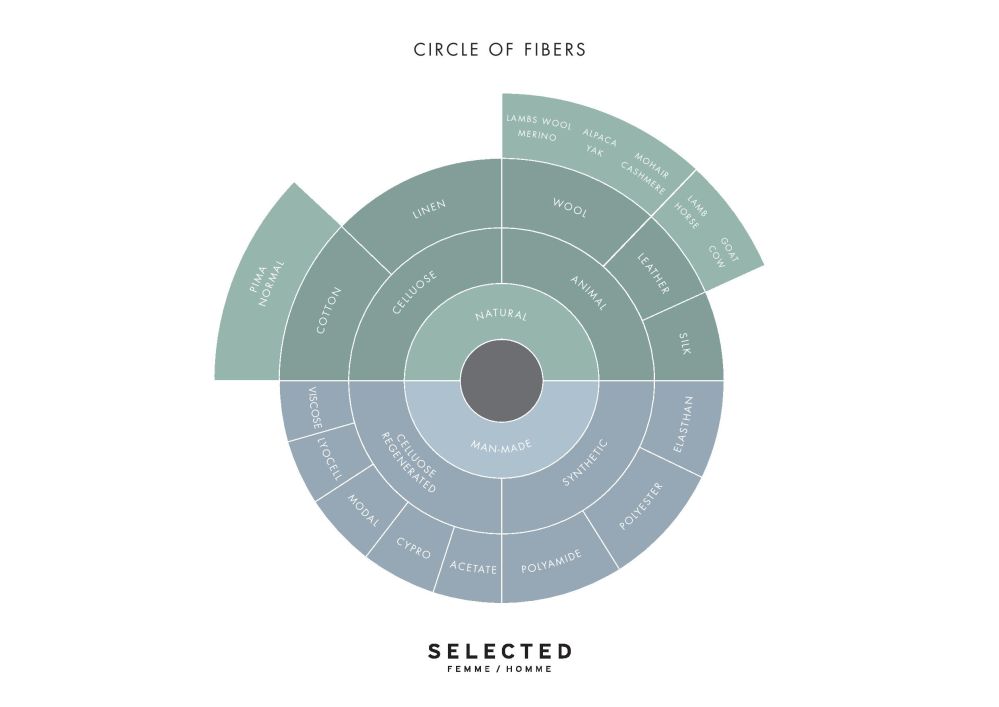Environmental awareness is important to our company and we are increasingly focusing on it every day, following the example of the Danish parent company BESTSELLER. Every year, our products are increasingly made from sustainable, environmentally friendly materials. The following is an overview of the environmentally friendly materials contained in the clothing we sell. Also, here are some tips on how to make your clothes last longer. Finally, we present our achievements so far and anticipate future changes in the production of more environmentally conscious products.
Material description

ORGANIC COTTON
Organic cotton is cotton grown and certified to organic farming standards. No harmful chemicals are used in the growing of organic cotton. / This natural process provides a better work environment for the farmers as it lets the soil stay fertile longer. / Organic cotton can be found in everything, from clothing, footwear and home furnishings.
ORGANIC LINEN
Organic linen is a natural fabric that is made from the fibres of the flax plant. / Organic linen is grown without the use of harmful chemicals like pesticides and fertilizers. / By growing linen without using hazardous chemicals, fields and wildlife are part of a healthier environment.
ORGANIC WOOL
Organic wool is a natural, renewable and durable fibre. / Organic wool has the ability to absorb moisture but also to release it – and therefore maintaining a perfect balance / Organic wool comes from sheep that are kept according to organic farming standards - with no use of mulesing, pesticides treatments or fertilizers.
ORGANIC MERINO WOOL
Merino wool is a natural fibre spun from the fleece of Merino sheep, raised per organic farming standards. / No mulesing procedures and no treatments with harmful chemicals like pesticides and fertilizers are used.
RECYCLED POLYESTER
Recycled polyester is made from recycled plastic (mostly from bottles) and polyester fabrics. / The plastic bottles are melted down and re-spun into new, high-quality polyester. / This way, plastic can be reused, natural materials are conserved, and waste is diverted from landfills and our oceans.
RECYCLED WOOL
Recycled wool is reclaimed from textile waste and unwanted or discarded garments. / Recycled wool reduces the environmental impact of the wool production. / Using recycled wool reduces waste and soil pollution as it consumes less energy and water.
RECYCLED COTTON
Recycled cotton is made from manufacturing waste like leftover fabric scraps or from used cotton garments and textiles. / Recycling cotton reduces the waste of a natural resource like water. / Recycled cotton reduces the amount of cotton waste that would eventually have ended up in landfills.
RECYCLED NYLON
Recycled nylon – also known as polyamide – is a synthetic material commonly sourced from post-industrial waste fibres – like leftover fabric scraps collected from the spinning factory and waste from weaving mills. / Recycling nylon fibres save natural resources and reduce the amount of textile waste.
TENCEL™ LYOCELL
TENCEL™ branded lyocell fibres are made from cellulose derived from wood pulp. / The pulp is derived from all-natural materials and converted into fibre through an innovative process. / The benefits of the fibre include softness, strength and breathability.
LENZING™ ECOVERO™
LENZING™ ECOVERO™ is an ecological and clean viscose fibre, strictly made according to the guidelines of the EU Ecolabel; a world-leading environmental manufacturing standard. / LENZING™ ECOVERO™ branded viscose fibres actively contribute to more sustainable fashion consumption because of its 50% lower emissions and water impact.
TENCEL™ MODAL FIBRES
TENCEL™ branded modal fibres are made of responsibly sourced wood pulp. / In an eco-responsible process, the wood pulp is turned into cellulose that is eventually spun into luxuriously soft and moisture absorbing fibres.
CUPRO
Cupro is a high-quality, cellulose fibre made from an often overlooked part of the cotton plant called cotton linter. / Cotton linter is processed in a fully sustainable conscious system and turned into cupro – a silk-like quality with a soft and smooth touch.
BCI-Better Cotton Intiative
We are a partner of the Better Cotton Initiative, which is to have a better future for cotton and those who depend on it for their livelihood.

Helpful hints
HAND WASH YOUR SILKS
Silk is a delicate material and should be treated as such. Machine washing is far too rough for such a fragile textile. To avoid shrinkage and reduce the risk of tearing, we recommend you hand wash your silk garments. Simply add a teaspoon of liquid soap to cold water and gently wash the garment. Do not soak it in the soapy water, a good dip will do. Make sure to rinse in cold water after washing.
REMOVE LINT AND PILLING
Soft and natural materials like cashmere, mohair, yak, and wool are prone to pilling. Rubbing during regular use may cause lint and pilling to build up. We recommend you treat your garments made from natural materials with extra care and gently brush them with a sweater stone or comb to remove excess pilling.
AIR OUT OR LINE DRY
To reduce wasting water and energy, think twice before washing. Some garments, like a woolen sweater or a pair of trousers, do not need to be washed that often. Instead, try airing and spot cleaning them first. Airing out or line drying will help regain that fresh feel. Remember: When hanging your clothes out to dry, do not hang them directly in the sun, as sun can bleach the garment.
YOUR RETIRED FAVORITES: REUSE AND RECYCLE
Are you bored with your sweater ? Perhaps your favorite dress is suddenly a little too tight ? Before disposing of your old clothes stop, take a moment, and think: Maybe you can pass it on to someone – like a friend, a relative, or a local charity. Donate clothes that are too worn out to a recycling unit. The fibers from your recycled clothes can be used to make new products. Recycling clothes saves raw materials, natural resources, and conserves energy. Extending the life cycle of your clothes will reduce the carbon footprint and gas emissions caused by the manufacturing process.
HOW TO CARE FOR YOUR JEANS
To extend the life of your jeans, here are a few simple care instructions. The process of cleaning your jeans is actually quite simple. In general, wash your jeans infrequently and inside out. Wait as long as possible before the first wash. Breaking in your raw jeans takes a little longer, so avoid washing these at least four to six months. Till then, spot clean stains with a sponge and a small amount of gentle ECO labeled detergent. Air outside. Never use the dryer as the heat will wear down the fibers. Ideally, hand wash your raw jeans in water (around 40°C). Refrain from scrubbing and rubbing the jeans. Let them soak for about 30 minutes and rinse with temperate water. Piece of friendly advice: lay down a towel to catch any dripping dye. New jeans can bleed indigo – so take preventative measure.
HOW TO CARE FOR YOUR TAILORING
To help you take care of your suit, we have put together a few easy-to-follow tips and recommendations. CREASING? If your suit is creased, try hanging it in the bathroom while running a hot, steamy shower – that should do the trick! In case you need a more thorough steam, use a handheld steamer or a steam iron to remove creases. Be careful not to iron directly on the surface of the suit as the heat can damage the fibers and leave the surface looking shiny. Instead, attach a cotton cloth or a Teflon™ shoe to your iron to shield from directly applied heat.
UPKEEP
During regular use, your suit will likely be exposed to dirt and dust. Remember to gently brush your suit every once in a while in order to remove any lint. The fabric brush – an environmentally friendly alternative to dry cleaning – is ideal for this purpose and should work even on larger marks.If in doubt about more exhaustive upkeep, leave it to your dry cleaner to assist you. Please note, though, that dry cleaning is hard on your suits. The chemicals used in dry cleaning will wear away the natural fibers and take years off its lifespan. So, limit your dry cleaning to just once a year and only if needed. We recommend using an eco-friendly dry cleaner whenever possible for a more environmentally gentle approach.
LET YOUR SUIT BREATHE
Day-to-day wear will cause your suit to hold a slight odor. Give your suit at least a day of rest after each use. Make sure to let your suit air in a ventilated room for a couple of days.
HOW TO STORE YOUR SUIT
When you are not wearing your suit we recommend you hang and store it in a dustproof garment bag, to make sure that your suit stays fresh. An added bonus: Hanging your suit allows creasing to straighten out naturally – and saves you the extra work. Leave the zipper open in order to let air circulate. Invest in a good quality wooden hanger that fits the size of your jacket in order to support the shape of the shoulders. Fold your trousers at the creases and hang it either upside down with a clip hanger or folded at the knee. Hanging a suit properly when not used ensures the shape and fitting of the suit lasts longer.

RESPONSIBLY CRAFTED, RESPONSIBLY WASHED
With a pioneering, all-organic jeans line, Selected Femme/Homme raises the level and sets a higher standard, pushing all boundaries for producing and washing sustainable denim.
While the climate debate increasingly raises our awareness, warning us of global warming and CO2 emissions, more and more brands are trying to do much better with eco-friendly capsule collections and innovative fibre innovation.
With an ambitious approach to production, Selected Femme/Homme has spent the last two years perfecting its sustainable portfolio, culminating in the launch of its ‘Responsibly Crafted’ brand statement this coming August.
Using more sustainable fibres has become such a natural part of developing and delivering its curated collections that the brand is now promising to make every collection as sustainable as possible to minimise its future environmental footprint.
Showcasing its ongoing commitment, Selected Femme/Homme is particularly advancing within the world of denim, otherwise known as a dirty business.
From autumn 19 and onwards, all new jeans are made from 100% organic cotton. And that’s not all! By staying curious and continuing to seek out new fields of knowledge, the Danish brand is equally proud to announce that from spring 20 its denim line is not only ‘Responsibly Crafted’ but also ‘Responsibly Washed,’ reducing resources and harmful chemicals associated with making jeans.
Generally speaking, the washing process is the most intense part of producing denim goods. It’s where jeans come to live so to speak and get their lived-in, authentic character. However, it’s also a process that demands a huge amount of water, energy, and chemistry.
Selected Femme/Homme has managed to create a lower environmental impact and much cleaner denim by using more efficient machines and sustainable treatments, measuring itself up against three different parameters: Water, energy, and chemistry.
Organic cotton: We’re very proud that all the cotton we use is 100% organic.
Less water: We use up to 75% less water with our new washing process. This reduces the impact majorly.
Less energy: More efficient washing machines have helped reduce power energy. This lowers the energy usage with up to 85%.
Less chemistry: By introducing more sustainable treatments like laser, we now use less chemicals and no salt.


